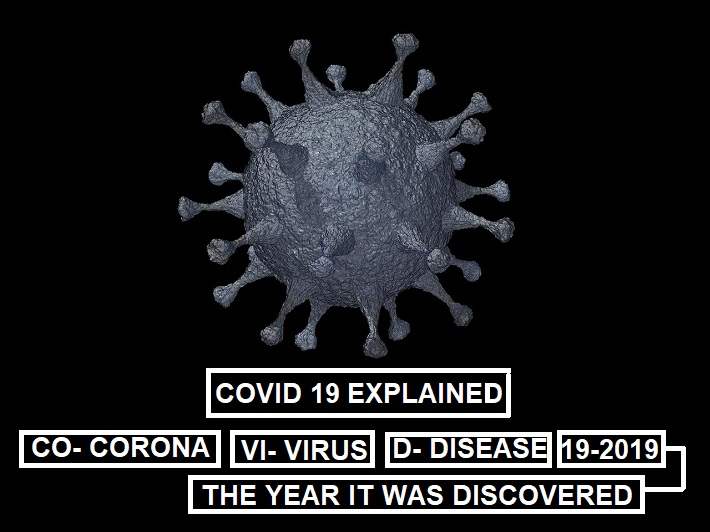

The Novel Coronavirus (COVID-19) that originated in Wuhan, China in November-December 2019, has been declared a global pandemic by the World Health Organisation (WHO).
The disease, with influenza-like symptoms, has spread to at least 177 countries in Asia, Europe, North America and the Middle East, causing the death of more than 14,700 people and infecting more than 340,000 others.
The WHO has designated the Novel Coronavirus as COVID-19. The first two letters ‘CO’ denotes ‘corona’ for the family of viruses that causes maladies ranging from a common cold to several more serious illnesses. ‘VI’ stands for virus, ‘D’ for disease and ‘19’ for the year it was discovered.
The coronavirus family, recognized in the 1960s got the name corona for the spikes on its surface that resemble the crown of a monarch or circle of light seen around a luminous body, like the sun or moon.
However, when viewed under more up-to-date equipment, it resembles a naval mine of the world war. It is playing havoc with public health and hospital systems much like the mines did with ships those days.
In the first stage, the number of cases is very small and manageable as it was in China in the early days. The infection was carried by travelers from virus affected countries to other places.
This is the best time to prevent further infection by locating and isolating such people even though they may not show any symptoms of sickness like that of a common cold—running nose, sore throat, cough or a slight fever.
The second stage, as in the case of India at present, is that of local transmission. The infected person coming from infected countries passes on the virus to relatives, relatives or friends. Some may show only mild symptoms and require isolation at home, but others who display signs of respiratory problems may require hospitalization and treatment. The number of infections and deaths are still in small numbers, but going up exponentially every week.
The third stage is the community transmission stage, in which even those people who had neither visited any country nor came in contact with any such person contracts the illness. The number of cases goes up to such an extent that hospitals and healthcare professionals face massive problems in dealing with the situation and deaths run into several hundred.
In the fourth stage, everything is practically out of control. Governments all over the world are working to prevent such a situation with all the means at their command. China seems to have managed to gain control and is reporting a fewer number of deaths.

Infections take place when the infected person releases droplets when he sneezes, coughs or talks to others in close proximity. The droplets containing the virus, enter the respiratory tract and once it reaches a cell, practically hijacks it and forces it to make replicas of the virus in large numbers. In severe cases, it affects the lungs, leading to Acute Respiratory Syndrome and death.
The SARS-CoV-2 genome is an RNA molecule of about 30,000 bases containing 15 genes, including the S gene which codes for a protein located on the surface of the viral envelope.
It belongs to the group of Betacoronaviruses that it is very close to SARS-CoV. The SARS virus had caused an acute pneumonia epidemic originating in November 2002 in the Chinese province of Guangdong. It then spread to 29 countries in 2003. A total of 8,098 cases were recorded, including 774 deaths.
While scientists suspect the virus to have jumped from an animal to human, making the immune system, used to tackling human-to-human transmitted virus, detecting the intruder early enough to fight and overcome it. There is also no effective vaccine as yet for COVID-19 even though labs and researchers across the world are engaged in the task. However, it may take several months or even years to develop a vaccine.
The fatality rate was more than 2% according to a study, but the US government scientists estimate the real figure could be below 1%, roughly the same that occurs in a severe flu season.
However, it is the speed with which it spreads in the third stage of community spread that is cause for concern. Hospitals and health workers would be overwhelmed by the sheer number of patients. There could also be a shortage of protective equipment for the healthcare professionals like full-body suits, masks, gloves as also equipment like ventilators and Intensive Care Unit (ICU) facilities.
While children and youth do not seem to be affected by the virus, those above 60 years, especially having diabetes, blood pressure and respiratory illnesses are at greater risk.
Men are also more likely to die probably because they have a weaker immune response and higher rates of tobacco consumption. Type 2 diabetes and high blood pressure may also increase the risk of complications following an infection.
Diagnostic tests for infection are available at hospitals and labs. Once the infection is confirmed, the treatment is mainly supportive, managing his or her fever and using a ventilator to pump air into the lungs if needed.
Patients with mild symptoms are told to rest and drink plenty of fluids. “Most people with mild infections recover in about two weeks. More than half of those who have been infected globally have already recovered.
Wash your hands with soap and water or use a hand sanitizer. Avoid touching your face and maintain a distance of at least six feet from anyone who is coughing or sneezing.
There is no need for healthy people to wear a mask. However, those suffering from a cold, cough or other transmittable infections should use masks.
Avoid frequenting public places. Restrict trips outside the home to getting essential groceries or medicines or depend on home delivery. If possible, work from home and contact colleagues through phone, skype or other such facilities. Postpone your holiday travel, especially by cruise ships and airlines.
A humble request from OneYearMBA Team
As our country is under lockdown for three weeks , please follow the instructions of the authorities that are meant to prevent a social spread of the infection. Save yourself. Save the country. Save the humanity.